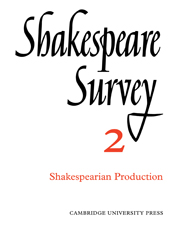Book contents
- Frontmatter
- Fifty Years of Shakespearian Production: 1898–1948
- An Original Drawing of the Globe Theatre
- The Projected Amphitheatre
- Ben Jonson and Julius Caesar
- The Booke of Sir Thomas More and its Problems
- The ‘Shakespearian’ Additions in The Booke of Sir Thomas More
- The Renaissance Background of Measure for Measure
- The Individualization of Shakespeare’s Characters through Imagery
- Trend of Shakespeare Scholarship
- Shakespeare in France: 1900–1948
- International News
- Shakespeare in New York: 1947–1948
- The Year's Contributions to Shakespearian Study 1 Critical Studies
- 2 Shakespeare’s Life and Times
- 3 Textual Studies
- Books Received
- Index
- Plate section
The Booke of Sir Thomas More and its Problems
Published online by Cambridge University Press: 28 March 2007
- Frontmatter
- Fifty Years of Shakespearian Production: 1898–1948
- An Original Drawing of the Globe Theatre
- The Projected Amphitheatre
- Ben Jonson and Julius Caesar
- The Booke of Sir Thomas More and its Problems
- The ‘Shakespearian’ Additions in The Booke of Sir Thomas More
- The Renaissance Background of Measure for Measure
- The Individualization of Shakespeare’s Characters through Imagery
- Trend of Shakespeare Scholarship
- Shakespeare in France: 1900–1948
- International News
- Shakespeare in New York: 1947–1948
- The Year's Contributions to Shakespearian Study 1 Critical Studies
- 2 Shakespeare’s Life and Times
- 3 Textual Studies
- Books Received
- Index
- Plate section
Summary
MS. Harley 7368 in the British Museum is the damaged and much revised manuscript of an Elizabethan play bearing the title “The Booke of Sir Thomas More”. It is known to have been in the collection of a certain John Murray of London in 1728; thence it passed into the library of the second Earl of Oxford, and with the rest of his manuscripts came into the possession of the nation in 1753. Nearly ninety years later it was first referred to in print in John Payne Collier’s edition of Shakespeare, but in 1844 the play was edited for the Shakespeare Society by Alexander Dyce. The manuscript had already suffered from decay, but Dyce’s transcript was a careful and reliable one. Since his time not only has the decay progressed but the manuscript hasbeen repaired in a particularly unintelligent fashion. Holes were patched with gummed paper, and the leaves that showed signs of crumbling—six in all—were pasted over on both sides with a semi-opaque tracing paper. As a result Dyce’s edition preserves many words and even lines that are no longer legible. Dyce’s edition, like Hopkinson’s (1902), was a limited one, and not until 1908, with the publication of C. F. Tucker Brooke’s Shakespeare Apocrypha, did the text become generally accessible. In 1911 a facsimile of the manuscript was included by J. S. Farmer in his series of Tudor Facsimile Texts, and later in the same year the play was edit for the Malone Society by W. W. Greg. Greg’s edition is likely to remain the dfinitive one; not only was the text prepared with exemplary care, but the various hands in the manuscript were first clearly distinguished and the relationship of the revisions to the original text was clarified.
- Type
- Chapter
- Information
- Shakespeare Survey , pp. 44 - 61Publisher: Cambridge University PressPrint publication year: 1949

